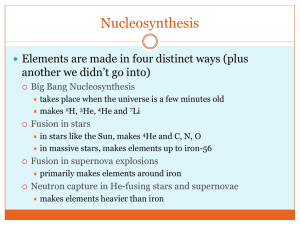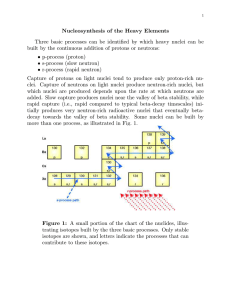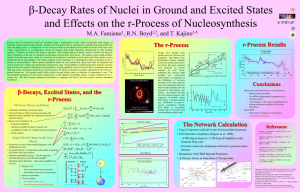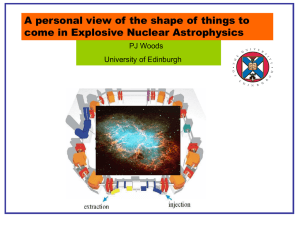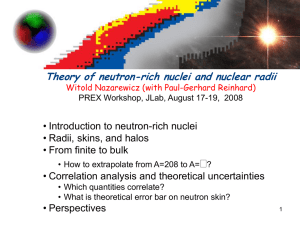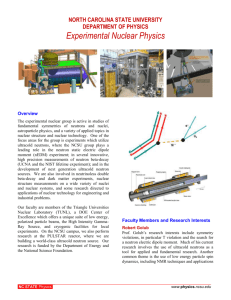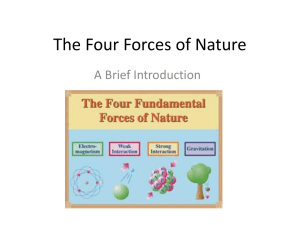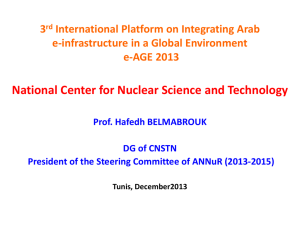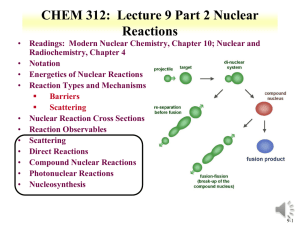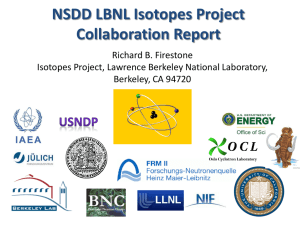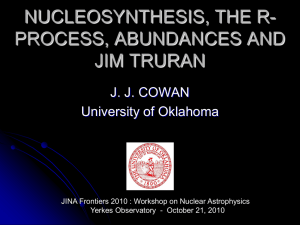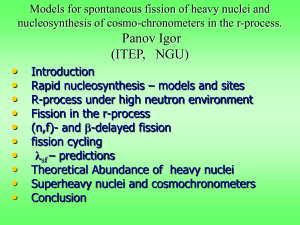Slides
advertisement
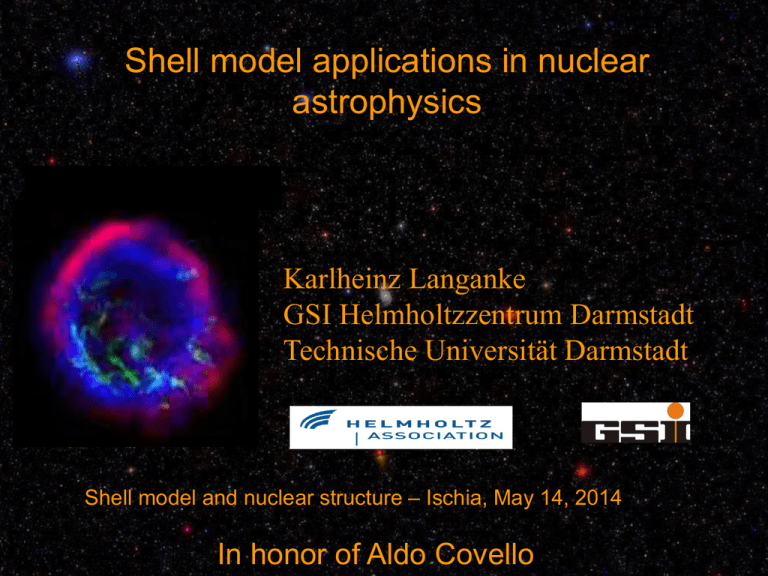
Shell model applications in nuclear astrophysics Karlheinz Langanke GSI Helmholtzzentrum Darmstadt Technische Universität Darmstadt Shell model and nuclear structure – Ischia, May 14, 2014 In honor of Aldo Covello Closer look on • electron capture in presupernova phase (nuclear composition A ~ 60) - electron capture during collapse (nuclear composition A > 65) - r-process in neutron star mergers Supernova: schematic view courtesy: R. Diehl Electron capture: Lab vs Stars Capture is dominated by Gamow-Teller transitions During collapse, electrons are described by Fermi-Dirac distribution with chemical potentials of order a few MeV Parent nuclei are described by thermal ensemble Calculating stellar capture rates data KVI Groningen Capture on nuclei in mass range A~45-65 calculated by large-scale shell model Capture rates are noticeably smaller than assumed before! Consequences of capture rates Heger Woosley Martinez Pinedo shell model rates for Fe-Ni nuclei slower by order of magnitude important changes in collapse trajectory Experiment vs shell model Cole, Zegers et al., PRC 86 (2012) 015809 Iron-nickel mass range under control With increasing density, less sensitivity to details of GT distribution -> models less sophisticated than shell model suffice, e.g. QRPA Abundances in Type Ia‘s Type Ia‘s have produced about half of the abundance of nickel-iron range nuclei in the Universe Modern electron capture rates solve inconstency problem in Type Ia supernova abundance production Martinez-Pinedo, Thielemann Abundance distribution during collapse Electron captures drive nuclear composition towards neutron-rich unstable nuclei Unblocking GT for nuclei with neutron numbers N>40 In Independent Particle Model, GT are Pauli-blocked for N>40 In reality, blocking does not occur due to correlations and finite T. Calculations of rates by SMMC/RPA model. Experimental GT distributions courtesy Dieter Frekers Neutron occupancies Data from transfer reactions: J.P Schiffer and collaborators Convergence with truncation level Cross-shell correlations converge slowly. Hence, models like thermofield dynamics model or finite temperature QRPA, which consider only 2p-2h correlations, do not suffice. (Zhi et al.) Consequences of shell model rates Janka, Rampp, Martinez-Pinedo Making Gold! Nature vs Humans Old stars in galactic halo have the same r-process abundances as the solar system for A>130, but not below. two distinct r-process sites? Johann Friedrich Böttger, Alchemist Inventor of European White China In Meissen, Germany The R-Process • • • • • Courtesy: K.-L. Kratz Masses Half lives Neutron capture rates Fission Neutrino reactions Potential r-process sites Neutrino-driven wind from a nascent neutron star in a supernova explosion (Woosley et al.) simulations show that conditions allow only for production upto second r-process peak Neutron star mergers Freiburghaus et al. Trajectories and reheating After initial adiabatic expansion and cooling, the nuclear reactions (mainly beta decays) lead to a reheating of the ejected matter. The temperatures are high enough to establish an (n,gamma)<>(gamma,n) equilibrium. Due to the extreme neutron densities, the r-process path runs through nuclei not far from the neutron dripline. A. Bauswein, H.-Th. Janka Abundance evolution in ns merger third peak produced like in classical r-process (neutron captures, beta decays) second peak produced by fission yields neutron captures after freeze-out lead peak produced by late alpha decays Mendoza, Martinez-Pinedo... Dependence of half lives Eichler, Thielemann et al. faster half lives shift the peak back in mass number due to faster consumption of neutrons Half lives around N=126 shell model: forbidden transitions important (Suzuki et al. Zhi et al.) data in neighborhood of N=126 show that half-lives are faster than believed (T. Nieto, KH. Schmidt et al.) faster matter flow through N=126 waiting points, faster consumption of neutrons faster fission cycling abundances and mass models Mendoza, Martinez-Pinedo et al. quite unsensitive to mass models, fission cycling dominates ns merger -> robust abundance pattern, like in old stars? Next-Generation Isotope Facilities TRIUMF/ ARIEL MSU/FRIB SPIRAL2 GSI/FAIR Isolde RIKEN/ RIBF GoogleinEarth: FAIR in 2020 2020 Austria China Finnland France Germany Greece India Italy Poland Romania Russia Slovakia Slovenia Spain Sweden Great Britain GSI today SIS 100/300 Future facility SIS 18 UNILAC CBM ESR Super FRS Rare-Isotope Production Target HESR Antiproton Production Target PP / AP FLAIR RESR CR Observers NESR 100 m CN DE ES FI FR GB GR IN IT PL RO RU SE RIBF contribution: masses FAIR Impact of nuclear half-lives Impact of nuclear half-lives on r-process abundances Knowing the half-lives we will constrain the dynamics of the supernova explosion The RIB Chance: New Horizons
